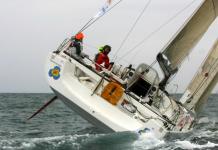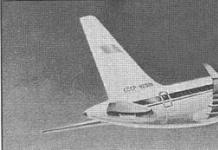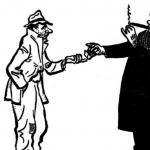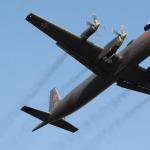As we said before - tilt angle(pitch) changes as vertical speed aircraft, and its air speed. Roll angle also significantly affects these characteristics. The thing is that during flight, the air created by the wings of the aircraft lift is numerically equal to the weight of the aircraft and practically does not change. Vector lift always directed perpendicularly aerodynamic plane(wing), i.e. – almost up, while lift clearly opposes (and compensates for) gravity– as shown in the top figure). If the plane rolls in any direction, the vector lift also deviates from its vertical position, i.e. not all anymore lift goes to fight gravity, and a certain horizontal component appears. Because of this horizontal component of lift the plane begins to descend ( gravity now more) and go to the side (towards the roll, because Total lift vector the plane is now pulling in this direction). It is clear that the more roll angle, the bigger this one will be horizontal component of lift, and therefore – less its vertical component– in this case, the plane will lose altitude faster (bottom picture).
The consequence of this is the fact that All planes lose altitude when turning! However, all aircraft are designed in such a way that in the event of loss lift try to restore it ourselves status quo. But how? After all, there are only two ways - attack angle And speed. Control angle of attack- in the pilot's hands. And here speed? It is due to speed the plane itself will try to compensate for the deficiency lift- therefore, during a turn, he will always try to put his nose down and accelerate. The pilot may or may not allow him to do this (but then he will have to add gas to remain at the same altitude and the same speed, or the pilot himself will have to pull the yoke (or control stick) during the turn - to increase attack angle, thereby again compensating for the lack lift). However, large angles of attack increase very much resistance, which when reversing affects the loss speed. The ability of the aircraft to make up for this loss heights, however, has its limits. Remember that by increasing attack angle, you tend to increase the dynamic load ? And this, in turn, increases aircraft weight, which greatly affects stall speed his wing. Consequently, at the moment the dynamic load increases, our wing will stall at much higher speeds than during straight flight.
In short, the greater the roll, the less angle of attack there will be a collapse. This effect is called reload dump, and it is much more difficult and dangerous than usual, if only because it gets hit while turning while banking. The higher the roll, the easier it is to fall. Hence the rule: do not fly with large banks at low altitudes, and even more so at low altitudes. speeds
Airspeed
Speed is life. You'll have to remember this. Without moving forward through the air, any wing will simply begin to fall down like a stone. A the faster we fly, the more stable and more controllable our canopy will be. Moreover, the faster we fly, the more lift we create and we can do with this by force anything - translate it into height, V speed, V resistance– it’s good when there is a lot of it. A wing is nothing without speed(although parachutes can sometimes do without it).
It is impossible not to say that high speed It also has its undeniable disadvantages, the main one of which is limited technical resources. Moreover, fast movements high in the sky and at ground level are two different things. The development of parachutes in the last few years has led to an increase in their speed by four to five times! On the one hand, this allows us to greatly increase the choice of sites on which we can try to land. But on the other hand, we now have in our hands a real aircraft, quite complex and dangerous, requiring the pilot (yes, the pilot!) Dome to have quite a lot of knowledge and skills to land it safely. Speed requires us to act quickly and correctly, and we must come to terms with this.
Depending on the size of the canopy and the flight mode, modern parachutes can move through the air at speeds from 0 to 160 km/h. But usually, the average speed of movement (i.e. not during acceleration) rarely exceeds 100 km/h. Compared to modern airplanes (2-3 times the speed of sound), we are turtles in the sky. We are significantly limited in speed, so where we need to go is the main criterion in choosing our speed. Although we are pilots of aircraft with the lowest air speeds, that is why we do not have wheels, but legs instead.
The most interesting thing for me, who is familiar with almost all manufacturers of modern domes in the world, is how we achieved such serious and impressive results. To tell you the truth, we're kind of hippies as artists, honestly. We take a piece of nylon fabric, a couple of strong ropes, and with the help of a sewing machine we turn it into a universally recognized flying machine. Why, then, did all this bright team of advanced smart heads make sure that their aircraft had almost zero stall speed? Everything is very simple - the total weight of the system is very small. The greater the weight of the device, the more difficult it is for it to move - this is the number one rule of all transport workers. (this is why birds have such a light skeleton - they don’t need strong bones). Thanks to near-zero speed conditions, we have the opportunity to control these aircraft without special training and without the need to graduate from college, as airplane pilots do.
Flying at speeds less than 200 km/h gives us many advantages. Firstly - resistance. It is this that takes away a lot of our energy and prevents us from moving forward. But it increases greatly with speed - in other words, the higher the speed of the aircraft, the more its shape matters. The aerodynamically ugly shape will only work at very low speeds. A good example would be observing the evolution of the shape of airplanes as the speeds at which they flew increased. The fact is that this axiom allows our body to calmly dangle, either parallel or perpendicular to the oncoming flow - without significantly affecting the energy consumption for resistance. More aerodynamically advanced canopies can easily glide along a very flat glide path, despite the large wing loading - precisely because the designer made sure that the overall drag was extremely low. And, of course, as you might suspect, these canopies are trying to fly at very high speeds, but more on that later.
Airspeed, together with the angle of attack, determines where the canopy moves. With a positive angle of attack, the faster the canopy moves, the more lift it creates. To control this accumulated force in your aircraft, you need to initially decide on its shape - yes, it is the shape of the dome that will be the decisive factor that determines the behavior in all modes of its operation. Although, of course, the entire system cannot work smoothly if at least one component is not working. As we have already said, flight is a joint effort of many factors. Not a single aspect of this system alone can provide this very flight. It is important to never forget this, without losing attention to a single seemingly trifle, because... This is precisely what may not be enough.
One of the main qualities that determine the seaworthiness of a vessel is its stability. Good stability of the yacht is, first of all, a guarantee in conditions of strong seas. The area installed on the vessel also depends on stability, which largely determines its speed performance. The term “stability” itself means the ability of a ship to resist roll. In this article we will dwell in more detail on this phenomenon - ship's roll.
Causes of ship roll
In maritime discipline is defined as the deviation of the diametrical plane of the hull from the vertical, conventionally drawn to the water surface. To put it more simply and intelligibly, roll is any deviation of the conventional plane of the hull from the horizontal position. There may be several reasons for this:
- The effect of waves on the hull of a ship, when, under the impacts of oncoming waves, the ship begins to sway and list on its side.
- The effect of wind on the sails of a yacht. Sharp gusts of strong wind can lead to the formation of a fairly large list, often causing the sailboat to capsize.
- Incorrect placement of cargo in the hold of the ship or its removal from the fastenings during rocking.
- The action of centrifugal forces when a yacht enters a sharp turn.
Vessel roll angle measured in degrees, indicating the degree of deviation of the horizontal position of its hull from the conventional horizon of the sea surface. In addition, the roll of the ship can be determined by the difference in draft between the starboard and port sides. If the port side draft is greater, then this hull position is called “ roll to port" When the vessel's draft is more to the starboard side, the situation is defined as a “list to starboard side.”
Types of ship roll
Depending on the reasons causing , it can be of several types. These include the following types.
Dynamic
The most common of all types of roll that any yachtsman has to face when going out to the open sea. It occurs under the influence of certain external short-term forces. Usually such forces are sharp gusts of wind or waves hitting the side. Dynamic roll, due to the short moment of its occurrence, rarely requires the intervention of a yachtsman. To be more precise, the crew most often simply does not have time to take any specific actions to eliminate the dynamic roll that has arisen.
As a result, the ship either self-levels, thanks to the stability reserve built into its design, or lies on its side. The ability of a ship to resist short-term dynamic roll determines its stability characteristics. Whenever yacht roll under the influence of an external force, oppositely directed equalizing forces immediately arise, tending to bring the ship to its original position.
Static
Called static , which arose under the influence of some static, that is, constant in magnitude, force. The cause of static roll is a shift in the center of gravity of the vessel to the stern/bow or to one of the sides. This is usually caused by incorrect alignment of the load or its displacement as a result of broken fastenings. In addition, the reason for the static list of the vessel can be the entry of water into the hull as a result of a hole. In this situation, the ship is in a heeled position even in the absence of external influence in the form of waves or wind. Static roll is defined as negative initial stability of the vessel, which, with additional influence of external forces, with a high degree of probability can lead to its capsize.

Longitudinal
Longitudinal roll, or trim, of a vessel is the imbalance of the draft of its stern and bow. When the draft of the stern is greater than the draft of the bow, this is a trim to the stern; if, on the contrary, then it is a trim to the bow. Longitudinal roll of the ship has a significant impact on the seaworthiness of the yacht. For small yachts, with a hull length of less than 10 m, the maximum permissible trim is considered to be a difference in draft of 5 cm. A larger stern draft reduces the speed of the boat, since an excessively submerged stern increases the resistance force of the water mass to movement.
Longitudinal roll increases the directional stability of a moving vessel. In this regard, the yacht obeys the rudder less well when it is necessary to change course. In addition, trim to the stern causes the boat to tend to fall into the wind. For boats whose main type of motion is planing, the stern trim makes it difficult for them to reach a stable glide path. The so-called “dolphining” effect is observed when the bow of the vessel is periodically thrown up and then dives down.
Longitudinal trimming to the bow also leads to a significant decrease in speed due to the “burrowing” of the bow into the waves, which increases drag when moving. A yacht trimmed at the bow becomes yawy, overly “responsive” to the slightest change in the position of the rudder, and holds its course worse. This is especially obvious when moving at an angle to the wave. The increase in water drag on planing boats also causes problems with reaching the glide path due to a decrease in speed. All of these problems can be avoided by correctly placing the load or ballast inside the hull.
Circulating
Circulating roll is the roll that occurs when a ship enters a turn. The magnitude of the circulation roll depends on the speed at which the ship maneuvers and the radius of curvature of the turn. Displacement vessels roll to the outside when entering a turn. Planing boats, due to the dynamic features of their movement, tilt, on the contrary, inside the turning radius.
Too sharp shifting of the rudder on vessels with low stability can lead to capsizing of the vessel. In addition, passengers and crew members who are not prepared for the maneuver may find themselves stranded due to a sudden list. Therefore, before entering a turn, the helmsman should foresee the danger of the yacht capsizing, and also warn the people on board about the upcoming maneuver.
Preventing ship roll
As you can see, heeling is a rather unpleasant phenomenon that can lead to quite serious consequences - people falling overboard, or even capsizing the ship. By the way, a coup is possible not only on board. In maritime history, there have been cases of ships turning over at full speed through the bow - this is supposed to be how the famous clipper Ariel, winner of the 1866 Tea Race, perished.
To prevent and combat heeling, entire leveling systems are installed on large ships. They include water tanks, pumps and compressed air cylinders, kingstons, and so on. Such “anti-roll” systems are part of the ship’s overall system of combating survivability, and make it possible to level out the resulting rolls and trims.

The roll angle is determined by a special device - an inclinometer. It is installed on the bridge of a ship or in the pilothouse of a yacht. There are usually two types:
- A plumb line fixed to a sector with degree divisions.
- Liquid based on the movement of an air bubble within a liquid.
Resistance to roll, increasing its critical readings, is the main task of ship designers. Today, many production yachts, among other technical requirements, are subject to stability standards. For cruising yachts, this figure is about 110-115 o. If you own a yacht, but do not know its ability to resist capsizing, then it is recommended to carry out an experimental inclining test. The boat, located near the shore, is artificially tilted until it falls on its side. Thus, data is obtained on the yacht’s ability to resist roll of various sizes.
When inclined, the shape of the underwater volume changes - the wedge volume WFWΘ comes out of the water, and the wedge volume LFLΘ enters the water.
As a result, when the vessel is inclined to the waterline WΘLΘ, corresponding to the inclined position of the vessel with a list in, the shape of the underwater volume changes and the center of the vessel’s size is no longer at point C, corresponding to the upright position of the vessel, but at point CΘ.
Since the center of gravity of the vessel G does not change position when tilting, a shoulder 1b appears between the weight force and the buoyancy force of the vessel, called the static stability shoulder.
In this case, the buoyancy forces form a restoring moment MΘ with the weight forces, which prevents the vessel from capsizing and, with the cessation of the heeling moment, returns the vessel to its original equilibrium position - to the waterline WL.
The righting moment is equal to the product of the stability arm for a given heel angle and the vessel's displacement: MΘ = lΘ - Δ, kH m
Where: MΘ - restoring moment at roll angle Θ,
gH - m lΘ – static stability arm at roll angle Θ, m;
Δ, - displacement of the vessel kH Initial stability of the vessel.
Regardless of the nature of the curve along which the center of magnitude of the vessel C moves during inclinations, we can take any small portion of this curve as an arc of a circle. Considering the initial section of the curve when the vessel deviates from a straight position and taking this section as an arc of a circle, we can assume that at small angles of heel, the center of this circle is at the intersection of the direction of action of the supporting force with the center plane;
this center - point pg - is called the transverse metacenter.
The radius of the circle along which the center of the quantity moves is called the transverse metacentric radius r. The stability of the vessel within the limits within which the above assumptions apply is called the initial transverse stability of the vessel.
For the elements of the initial transverse stability of the vessel, here and below the following designations are adopted:
zg - elevation of the center of gravity above the main plane, m;
zc - elevation of the value center above the main plane, m;
zm is the elevation of the initial transverse metacenter above the main plane, m;
r - initial transverse metacentric radius, m;
h is the elevation of the initial transverse metacenter above the center of gravity (initial transverse metacentric height), m;
a = zg - 2C - elevation of the vessel’s center of gravity above the center of magnitude, m.
In ship theory, it is proven that the value of the transverse metacentric radius r depends on the transverse moment of inertia of the waterline area: r = lx: - (1.5) where lx is the transverse moment of inertia of the waterline area. The value of the transverse metacentric height h = r - a = r + zc - zg, m. (1.6) For initial stability lΘ = h sin Θ, m; МΘ = Δh sin Θ, m (1.7) МΘ = ΔhΘ, kN m (1.8). Considering that for small angles of roll sin Θ = Θ (here Θ - in rad), Formulas 1.7 and 1.8 are called metacentric formulas for ship stability, since they are based on the assumption that with equal volume inclinations the center of magnitude moves in a circle with the center at the metacenter m, i.e., that the metacenter does not shift within these inclinations.
The product h is called the lateral stability coefficient of the vessel. The conditions for the equilibrium of a vessel under the action of a heeling moment on it can be written in the form of the equality Mkr = MΘ, kN m Hence the roll angle corresponding to the equilibrium of the vessel under the action of a heeling moment Mkr Θ = Mkr: Δh, rad. (1.9)
Taking the heel angle 6 = 1° = 1/57.3 rad in equality 1.9, we obtain the moment heeling the ship by 1°: М1о = - : 57.3, kN m/deg (1.10) Knowing the moment heeling the ship by 1° , you can quickly determine the ship’s roll in degrees under the influence of a given heeling moment: Θ = Mkr: M1o, deg. (1.11)
The metacentric stability formula is used at heel angles of up to 12 - 15 degrees, if at these inclinations the shape of the wedge volumes entering the water does not differ sharply from the shape of the wedge volumes of the ship's hull exiting the water, i.e., if the open deck does not enter the water or does not exit the ship's bilge out of the water (which usually happens when low-sided ships tilt).
(from the French car(é)ne - keel; underwater part of the ship or from the Dutch krengen - lay the ship on its side) - deviation of the plane of symmetry of the aircraft from the local vertical to the earth's surface. It is characterized by the K angle and K speed. Roll angle(γ) - angle between the transverse axis OZ and the axis OZ(m) of the normal coordinate system ( cm. coordinate system) shifted to a position where the yaw angle is zero. Angle K is considered positive when the OZg axis is aligned with the OZ axis by rotating clockwise around the OX axis when viewed along this axis. When determining the orientation of the velocity coordinate system (SV) relative to the normal one, it is used speed roll angle(γ)a, defined similarly to the angle (γ), but instead of the OZ axis, the lateral OZa axis is considered. When describing the movement of rockets they use aerodynamic bank angle(φ)n, defined as the angle between the OY axis and the OYn CK axis associated with the spatial angle of attack.
The roll of an aircraft is also the name given to the movement in which the bank angle changes; characterized roll rate(ω)x - projection of the angular velocity of the aircraft onto its longitudinal axis. The speed of rotation is considered positive when the aircraft rotates clockwise around the OX axis. When analyzing K. they often use dimensionless speed K. -(ω)x, related to the speed of K. by the relation
(ω) = (ω)xl/2V,
where l is the wing span of the aircraft, V is the flight speed.
The dimensionless speed of K is also called helix angle described by the tip of the wing.
Aircraft maneuvers are used, for example, during turns, when performing aerobatic maneuvers, and during landing approaches to counteract the displacement of the aircraft’s trajectory relative to the axis of the runway. Control of the gearbox is carried out by lateral control bodies ( cm. Controls). Spontaneous flight of an aircraft is called a fall. Cm. also Lateral movement.
- - ne - keel; underwater part of the ship or from the Dutch krengen - to lay the ship on its side) - deviation of the plane of symmetry of the aircraft from the local vertical to the earth's surface...
Encyclopedia of technology
- - vertical deviation. plane of symmetry of the aircraft. ship from the vertical to the earth's surface. LA roll is called. also movement, during which the roll angle changes...
Big Encyclopedic Polytechnic Dictionary
- - the inclination of the ship to one side, for example, during lateral courses, is measured with an inclinometer - an instrument consisting of a metal sector, the arc of which is divided into degrees, and in the middle it stands 0 ...
Encyclopedic Dictionary of Brockhaus and Euphron
- - the position of an aircraft or vessel in which the plane of its symmetry is deviated from the vertical towards the earth's surface. K. occurs during turns and other maneuvers of the aircraft...
Great Soviet Encyclopedia
- - ...
Spelling dictionary of the Russian language
- - see heel...
Dahl's Explanatory Dictionary
- - -and husband. 1. Tilt to one side. Give to. Put the plane in room 2. transfer. Unilateral change in direction...
Ozhegov's Explanatory Dictionary
- - roll, husband . 1. Tilt of a ship or aircraft on its side. The steamer is moving with a strong list. Give a roll. 2. transfer Bias, change in political orientation. The Austrian socialists have made a big tilt to the right...
Ushakov's Explanatory Dictionary
- - roll m. 1. Lateral tilt. 2. Deviation of someone or something from a vertical position. 3. transfer Change of direction in any activity...
Explanatory Dictionary by Efremova
- - a, m. 1. Lateral tilt of a ship, aircraft. Give. □ They hoped that the armadillo would straighten out, but it stubbornly grew larger. Novikov-Priboy, Tsushima...
Small academic dictionary
- - ...
Russian spelling dictionary
- - "tilt to one side." According to Matzenauer, from the French. carène "hull of a ship"; but rather from the Dutch: cf. walk, roll...
Vasmer's Etymological Dictionary
- - KREN a, m. carène f., English. carren, goal krengen 1. mor. The underwater or lower part or surface of the Vessel at the waterline. Marine science. 386. // Sl. 18 10 249. 2. Tilt of the vessel to one side. Sl. 18...
Historical Dictionary of Gallicisms of the Russian Language
- - The condition of a tilted ship, the ship's evasion due to the wind or due to the transfer of weights to one side, for underwater repairs...
Dictionary of foreign words of the Russian language
- - ...
Word forms
- - Cm....
Synonym dictionary
"Lurch" in books
From the book Memorable. Book one author Gromyko Andrey AndreevichChapter III. A TURN IN FOREIGN POLICY: THE SWAMP OF THE SPANISH WAR
From the book Napoleon, or the Myth of the “Savior” by Tulard JeanBeetroot with horseradish (yoshkarushmen kren dene)
author Ershov Semyon GordeevichSterlet with horseradish (sterlet Kren Dene)
From the book Mari national dishes author Ershov Semyon GordeevichLeft roll
From the book Mythology of the Holodomor author Prudnikova Elena AnatolyevnaLeft tilt But after this, after the first reports of success, the collectivization process drifted to the left. The personnel on the ground were such that they were happy to not only run ahead of the locomotive, but were ready to fly ahead of the plane. If he winds it around the propeller... then they will sing “You
§ 1. Dangerous list
From the book History of Russia. XX century author Bokhanov Alexander Nikolaevich§ 1. Dangerous tilt Revolution is a special type of historical movement. Within a relatively narrow chronological framework, the flow of events accelerates to the limit, carrying with it many forces that were still dormant yesterday, eroding and collapsing social institutions and relationships that have become dilapidated,
The doctrine of intervention and the drift from it
From the book Memorable. Book 1. New Horizons author Gromyko Andrey AndreevichThe doctrine of intervention and the shift from it After a relatively short period of time after the Geneva meeting of the leaders of the four powers, Washington began to tighten the course of its policy “from a position of strength”, “balancing on the brink of war”. The most zealous
Bank
From the book Great Soviet Encyclopedia (KR) by the author TSBRoll Roll (from the French car?ne - keel, underwater part of a ship or from the Dutch kren-gen - lay the ship on its side), the position of an aircraft or ship in which the plane of its symmetry is deviated from the vertical to the earth's surface. K. occurs during turns and other maneuvers
On its side) - the deviation of the plane of symmetry of the aircraft from the local vertical to the earth's surface. It is characterized by the K angle and K speed. Roll angle(γ) - angle between the transverse axis OZ and the normal axis OZ(m) ( cm. coordinate system) shifted to a position where the yaw angle is zero. speed roll angle(γ)a, defined similarly to the angle (γ), but instead of the OZ axis, the lateral OZa axis is considered. When describing the movement of rockets they use aerodynamic bank angle(φ)n, defined as the angle between the OY axis and the OYn CK axis associated with the spatial angle of attack.
The roll of an aircraft is also the name given to the movement in which the bank angle changes; characterized roll rate(ω)x - projection of the angular velocity of the aircraft onto its longitudinal axis. The speed of rotation is considered positive when the aircraft rotates clockwise around the OX axis. When analyzing K. they often use dimensionless speed K. -(ω)x, related to the speed of K. by the relation
(ω) = (ω)xl/2V,
Angle K is considered positive when the OZg axis is aligned with the OZ axis by rotating clockwise around the OX axis when viewed along this axis. When determining the orientation of the velocity coordinate system (SV) relative to the normal one, it is used
The dimensionless speed of K is also called helix angle described by the tip of the wing.
Aircraft maneuvers are used, for example, during turns, when performing aerobatic maneuvers, and during landing approaches to counteract the displacement of the aircraft’s trajectory relative to the axis of the runway. Control of the gearbox is carried out by lateral control bodies ( cm. Controls). Spontaneous flight of an aircraft is called a fall. Cm. where l is the aircraft, V is the flight speed.
also Lateral movement.
. Aviation: Encyclopedia. - M.: Great Russian Encyclopedia. 1994 .Editor-in-Chief G.P. Svishchev:
Synonyms
See what “Kren” is in other dictionaries: bank - roll, and...
See what “Kren” is in other dictionaries: Russian spelling dictionary Morphemic-spelling dictionary
See what “Kren” is in other dictionaries:- a, m. carène f., English. carren, goal krengen 1. mor. The underwater or lower part or surface of the Vessel at the waterline. Marine science. 386. // Sl. 18 10 249. 2. Tilt of the vessel to one side. Sl. 18. The roll when testing the slope with guns decreased somewhat. CSF 2 30 ... Historical Dictionary of Gallicisms of the Russian Language
Models of the aircraft Kren (from the French carène keel, the underwater part of the ship or from the English kren gen ... Wikipedia
- (English careen, from Latin carina - underwater part of the ship). The condition of a heeled ship, the ship's deviation due to the wind or due to the transfer of weights to one side, for underwater repairs. Dictionary of foreign words included in the Russian language.... ... Dictionary of foreign words of the Russian language
Cm … Synonym dictionary
Kren, roll, husband. (specialist.). 1. Tilt of a ship or aircraft on its side. The steamer is moving with a strong list. Give a roll (tilt). 2. transfer Bias, change in political orientation (newspaper). The Austrian socialists have made a big shift to the right... Ushakov's Explanatory Dictionary
A; m. 1. Lateral tilt of a ship or airplane. Give the ship's K. K. increases. 2. Change of direction, turn in political, social, etc. activities. K. left, right. Take it to the side. * * * ROLL ROLL (from Dutch krengen to lay the ship on ... ... encyclopedic Dictionary
KREN, ah, husband. 1. Tilt to one side (of a ship, aircraft, vehicle). Give to. Put the plane in room 2. transfer. Unilateral change in direction. Ozhegov's explanatory dictionary. S.I. Ozhegov, N.Yu. Shvedova. 1949 1992 … Ozhegov's Explanatory Dictionary
ROLL, see heel. Dahl's Explanatory Dictionary. IN AND. Dahl. 1863 1866 … Dahl's Explanatory Dictionary
- (List, heel, heeling) 1. Transverse inclination of the vessel. 2. The tilt of the aircraft about the longitudinal axis. 3. The underwater part of the ship along the waterline (old). Samoilov K.I. Marine dictionary. M.L.: State Naval Publishing House of the NKVMF of the USSR ... Marine Dictionary
Books
- My gentle shore, Krenev P.. The book of the famous modern prose writer includes works telling about life in the Russian North about modern Pomors inhabiting the shores of the White Sea. This is a reliable, true story...


















